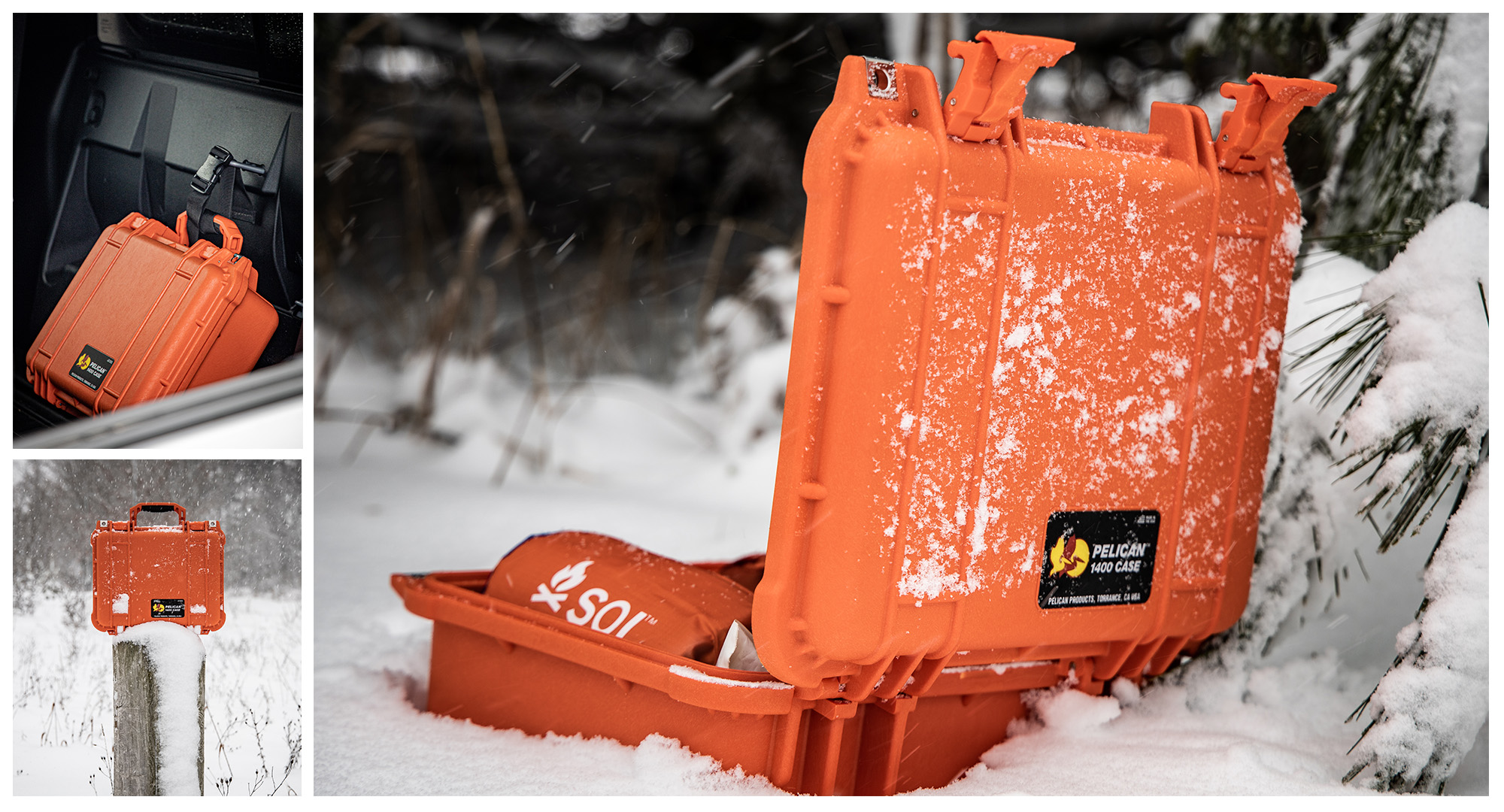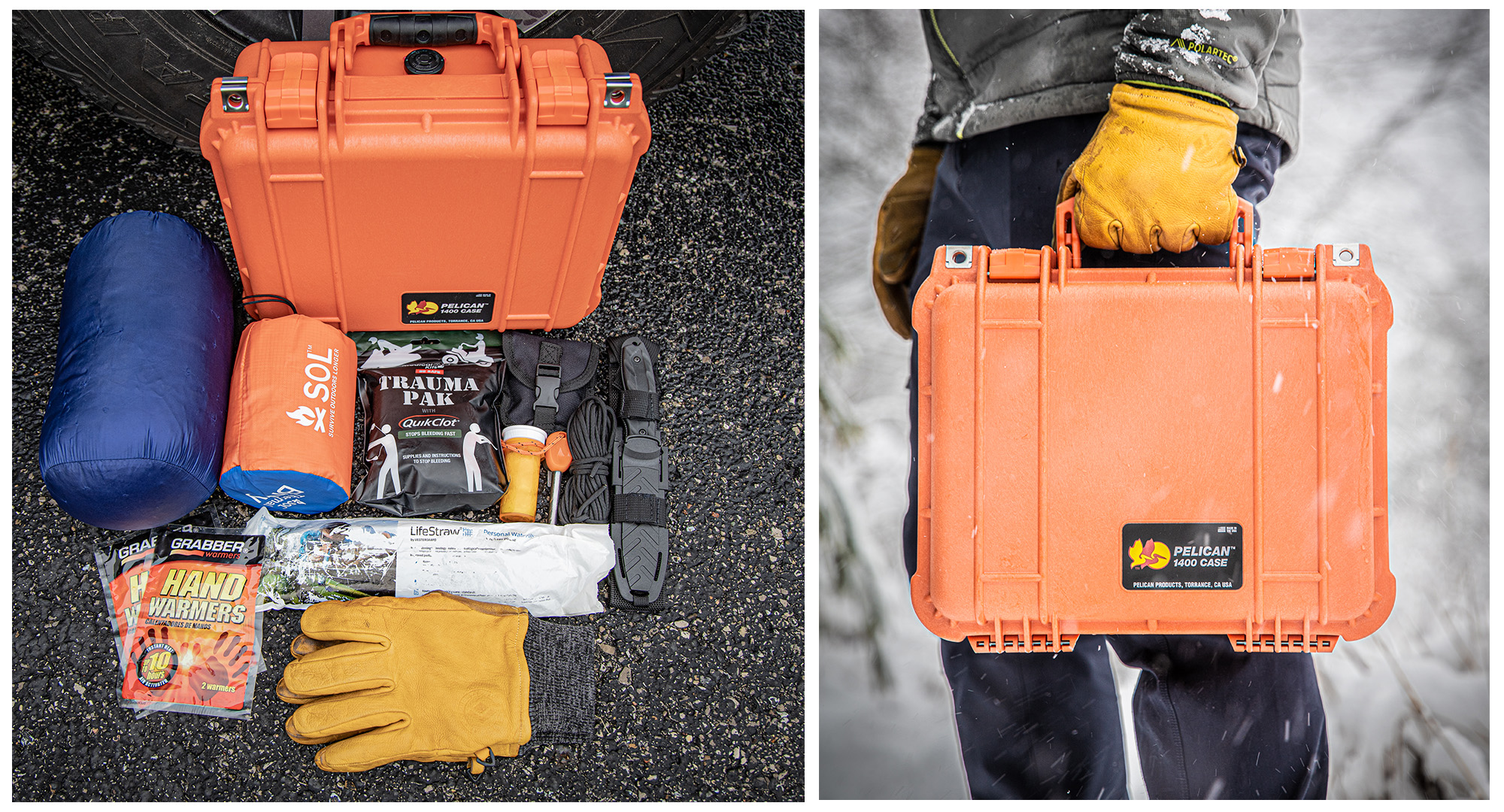A Guide to Creating Your Own Winter Preparedness Kit
December 15, 2020
What does it take to survive in the outdoors in Winter? Or perhaps we should rephrase that question into something more specific, what can we all do to better prepare ourselves for a Winter Season emergency situation - accident, breakdown or getting lost.
Thankfully we knew just who to ask. Members of our 2021 Pelican PRO Team are extremely well suited to help us advance our knowledge of Winter Survival Prep as they both serve as active duty rescue professionals in extreme cold weather climates.
Wryan Webb is a helicopter rescue pilot and outdoor enthusiast with a passion for photography. Wryan grew up in West Texas and is no stranger to the desert, but for the past 12 years he has been growing a career in the maritime environment as an aviation rescue professional. Currently living in northern Michigan, he has spent the last few years exploring the Great Lakes region with his wife and two dogs.
Bradley Pigage is a photographer and Coast Guard Helicopter Rescue Swimmer based in Kodiak, Alaska. In addition to capturing aviation photography, he loves to take his passion to the outdoors, photographing all things Alaska.
We’ve asked these experts to help us assemble the ultimate Winter Preparedness Kit, by answering these 5 basic questions:
- Scenarios: What are you preparing for? What do you view as some of the most likely Winter Survival Situations you might encounter?
Brad: Once you leave the beaten path of plowed roads, your likelihood of an accident increases. Whether your car gets stuck trying to push through snow, or you end up in a ditch from black ice, having a proper kit with you can be the difference in getting out, or staying alive.
Wryan: It’s hard to prepare for everything, a survival situation usually arises when something has gone wrong or when something entirely unanticipated occurs to put you in the situation. For me, that most likely means an accident on the road, an accident while hiking in the woods, or an accident while out flying the helicopter on a mission. - Cases: What size cases are you using to hold your emergency preparedness kit? Smaller is better because it’s easier to transport or large because you can keep everything you need inside?
Brad: For my truck, I carry the Pelican 1500 case. It fits everything I need from a backcountry snow shovel, to a small stove for melting snow. Depending on your environment, and how remote you travel will determine the size of your kit.
Wryan: It depends where I’m headed. Usually, I keep some truck recovery gear and extra wool blankets in my truck - something like a Pelican Cargo case would keep blankets and down sleeping bags dry and ready for when they’re needed. But the core of my survival kit is kept in a bright orange Pelican 1400 case that is easy to grab in a pinch.
- Kit: What are your most critical elements within your preparedness kit? Top 5? What are the nice to haves after that?
Brad: The most critical piece of gear you can have is a form of communications. If you plan to adventure out of cell phone range, I recommend looking into some sort of satellite GPS device like a Garmin InReach. They have saved countless lives. My top five items other than an InReach include chains, snow shovel, tire tracks, cold weather gear, and a small stove for melting snow.
Wryan: I try to keep it realistic, a true survival kit is something that will keep me alive until help comes. First, help needs to know where to look for me. To Brad’s point, a GPS locator or communicator is one of the best things to keep in the kit. After that, fighting dehydration and hypothermia are my next biggest concerns, so I have a water filter and a solid fire-starting kit that includes a knife. Nice to haves include my Pelican flashlight, 550 paracord, basic first aid, and extra cold weather clothes.
- Application: How have you used your kit in the past?
Brad: I slid into an embankment heading up one of our local passes here in Kodiak two winters ago. Thankfully, I was heading up to do a snowshoe session so I was well dressed. There was no damage to the vehicle, thankfully, so I cleared around the tires with a snow shovel, and placed chains on (which I should have had on before). I was out of cell range, so thankfully I had the gear I needed, and had an inreach if I had to use it.
Wryan: I was in a scary situation once where I was stuck in the snow with cars zipping by and a couple times I’ve been out in the woods in waist deep snow after dark because the hike took longer than expected. Thankfully, I was able to free my truck from the snow with the help of a good samaritan and I’ve never had to build a makeshift camp in the woods and send for help. However, I make it a point to practice using my gear so that I stay sharp. For example, when I’m camping with my family I still pull out my survival kit and use it to start a fire.
- Acquisition: Where do you get your gear - how do you evolve your kit and the skills to use what’s within?
Brad: Any local outdoor store should carry satellite GPS devices and a backcountry snow shovel. Make sure you get the right chains for your vehicle, and to put them on BEFORE heading out! You do not want to be putting your chains on for the first time when it’s blowing snow. Finally, don’t buy the most expensive winter gear just for your kit. You don’t need to look stylish when you’re digging yourself out of the snow; You just need to be warm.
Wryan: Most of my gear I’ve pieced together over the years, finding what works best for me. There’s a balance between buying junk that’s too cheap or just marketed well and spending a fortune on the top of the line stuff. The important thing is to continue to refine your gear and your pack as you grow your skills and venture into different environments that might require different tools. There’s a wealth of knowledge out there about the skills needed to survive, but if you never practice things for yourself you’ll be less likely to do well when it counts.
We asked Wryan to provide a list of the gear he keeps protected and ready to deploy in an emergency situation within his Pelican 1400 Protector Case:
- Garmin InReach Explorer+
- Vaseline-soaked cotton balls in a waterproof canister (i.e. film canister, empty prescription med tube, etc.)
- Ferro rod/Flint stick
- Fixed blade knife
- Pelican flashlight
- Pocket chainsaw
- 550 paracord
- Basic First Aid kit
- Water filter
- Emergency bivy/signaling tarp
- Extra cold weather gear
- Wool blankets
- Down sleeping bag
- Recovery straps, shackles, and other winching tools
- Recovery traction boards
- Snow shovel
- Snow shoes
- Emergency food rations
Winter Preparedness is about more than unlimited loads of latest gear; it's the evolution of knowledge about what is essential, and what’s too much gear to consistently have with you. The progression of this knowledge is a lifelong journey, and so our Survival Kits are (hopefully) a reflection of your own personal knowledge.
A special thank you goes out to both of our Pelican Pro team members for their service to our country and for taking the time to share their experience with us. We hope this entry and others to come will continue to advance our audience’s knowledge of how to better equip their winter preparedness kit. We highly recommend exploring the Pelican product line of both cases and flashlights to better optimize your own kit, and please tag us on social media so we can share your setup!




















